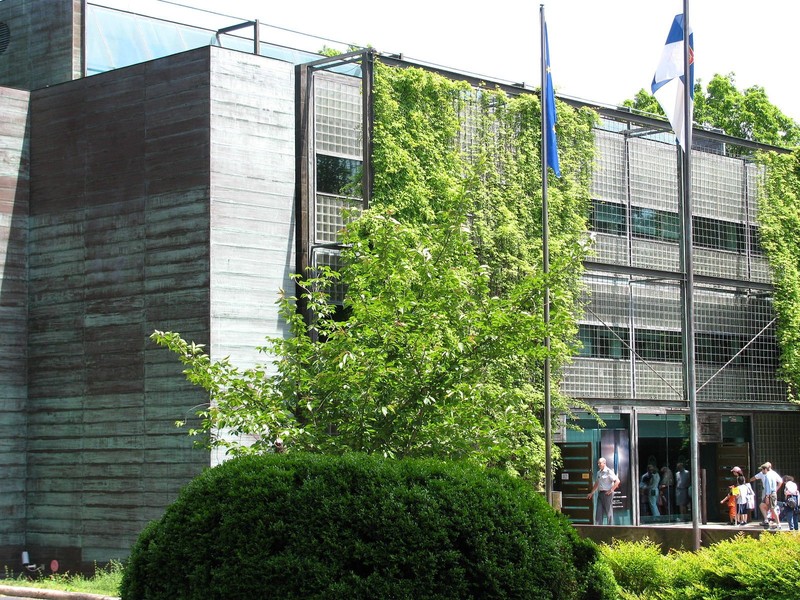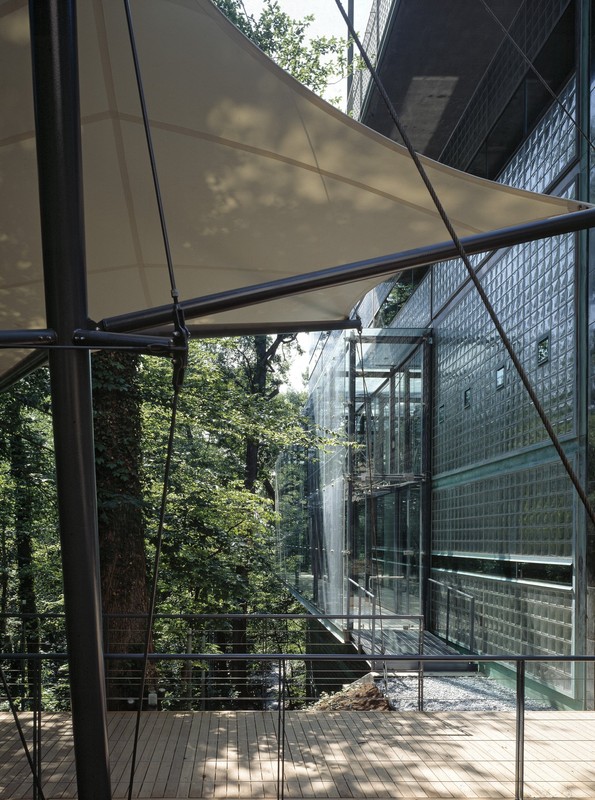The Embassy of Finland
Introduction
Text-to-speech Audio
Images
The Finnish Embassy is the first and only LEED Platinum embassy building in the United States. Photo by Slowking4 on Wikimedia.

The Finnish Embassy uses natural light as one method of reducing energy consumption. Photo courtesy of the Embassy of Finland.

Backstory and Context
Text-to-speech Audio
Seeing the United States as a "companion" country, the Finnish Embassy works to strengthen American-Finnish relations. These relations began in 1919 after Finland declared independence from the Russian Empire in 1917. The United States briefly suspended relations during World War II, in which Finland allied with Nazi Germany to receive assistance in the fight against the Soviet Union. After reestablishing relations in 1945, Finland provided the United States with an important ally during the Cold War. Since then, the United States and Finland have maintained a strong partnership and that has benefited both countries’ economic, diplomatic, technological, human rights, and peacemaking initiatives.1
The Finnish Embassy serves a number of important purposes. Diplomats communicate information about Finland's policies and legislation to American politicians. At the same time, the Finnish Embassy collects information on American positions on global issues. This information shapes Finland's understanding of American decision-making and informs their own decision-making processes. The Finnish Embassy protects and defends the rights of Finnish citizens in the United States, while also promoting culture and heritage. The Finnish Embassy hosts cultural events and tours, which are open to the general public. There are also consulates general in New York and Los Angeles.2
Finland has had a
representative body in Washington, D.C. since 1921.
Representation began as a legation and was upgraded to
an embassy on September 10, 1954. After multiple
moves around D.C., the embassy arrived at its
current location, 3301 Massachusetts Ave. NW, in
1994.3 This location situates Finland among the diplomatic and
architectural greats of Embassy Row. At the same time, the building's
innovative, contemporary design sets the Finnish Embassy apart from its neighbors.
The building, according to the Finnish Embassy, is "a refreshing exercise in understatement with a combination of boldness,
self-confidence and simplicity."4 Its clean lines, open space, and industrial appearance reflect the Finnish
people’s resourcefulness. The building was also designed with guests in mind. The
space is easily customizable for exhibits, events, concerts, and dinners. Most
uniquely, the Finnish Embassy is home to a sauna, a common expression of
hospitality in Finland. The Diplomatic Finnish Sauna Society of D.C. organizes exclusive
monthly gatherings of politicians, lobbyists, diplomats, and occasionally reporters
to exchange ideas and promote Finnish culture.5
The Finnish Embassy
building embodies Finland’s Earth-conscious ethos. Finland was named the most
environmentally-friendly country in 2016 according to the Environmental Performance Index. The Finnish Embassy building uses environmentally
friendly materials and methods such as natural lighting, occupancy sensors, and high efficiency
faucets. The building is maintained with low-impact cleaning supplies and no
smoking or plastic cups are allowed. Staff take advantage
of on-site recycling and composting programs and often bicycle and drive of hybrid vehicles.
The Finnish Embassy has been awarded historic honors for these efforts. It was the first embassy to receive the Environmental
Protection Agency's Energy Star for efficiency. In 2010, the building was awarded LEED Gold Certification by the U.S. Green
Building Council. In 2015, this certification was upgraded to Platinum level,
also the first for an embassy in the United States. Finland is leading
the way in green energy and sustainable design, which the United States Embassy
in Helsinki, the only other Platinum certified embassy in the world, is also embracing.
These efforts reflect the strong relationship between Finland and the United
States.6
Sources
1. U.S. Department of State, "A Guide to the United States' History…," Office of the Historian;
Embassy of Finland, "Welcome to the Finnish Embassy," Ministry for Foreign Affairs of Finland; U.S. Department of State, "U.S. Relations with Finland,” Bureau of European and Eurasian Affairs Fact Sheet.
2. The World Factbook: Finland; Embassy of Finland, "Welcome to the Finnish Embassy," Ministry for Foreign Affairs of Finland.
3. Embassy of Finland, "History," Ministry for Foreign Affairs of Finland.
4. Embassy of Finland, "Embassy of Finland," Ministry for Foreign Affairs of Finland.
5. Embassy of Finland, "Embassy of Finland," Ministry for Foreign Affairs of Finland; Sopher, “Networking Naked with Finland’s Diplomatic Sauna Society,” The Atlantic.
6. Rogin, "Finnish Embassy awarded for going green,” Foreign Policy; Embassy of Finland. "Finland Embassy Platinum LEED Factsheet." Ministry for Foreign Affairs of Finland.
Embassy
of Finland. "Embassy of Finland" Ministry for Foreign
Affairs of Finland. Accessed October 2017. http://www.finland.org/public/default.aspx?nodeid=35836&contentlan=2&culture=en-US
Embassy of Finland. "Finland Embassy Platinum LEED Factsheet." Ministry for Foreign Affairs of Finland. Accessed October 2017. http://www.finland.org/public/download.aspx?ID=139290&GUID=%7BA6C2CFF9-DABC-4C75-8A74-8EF8CB92411C%7...
Embassy of
Finland. "History." Ministry for Foreign Affairs of
Finland. Written by Marja Guercin. Accessed
October 2017. http://www.finland.org/public/default.aspx?nodeid=35837&contentlan=2&culture=en-US
Embassy of
Finland. "Welcome to the Finnish Embassy." Ministry for
Foreign Affairs of Finland. November 07, 2016. Accessed October 2017. http://www.finland.org/public/default.aspx?nodeid=35834&contentlan=2&culture=en-US.
Rogin, Josh.
"Finnish Embassy awarded for going green." Foreign Policy. January 20, 2010. Accessed October 2017. http://foreignpolicy.com/2010/01/20/finnish-embassy-awarded-for-going-green/
Sopher, Philip. “Networking
Naked with Finland’s Diplomatic Sauna Society.” The Atlantic. March 6, 2015. Accessed October 2017. https://www.theatlantic.com/international/archive/2015/03/networking-naked-with-finlands-diplomatic-...
The World Factbook:
Finland. Central Intelligence Agency. January 12, 2017. Accessed March 15,
2017. https://www.cia.gov/library/publications/the-world-factbook/geos/fi.html.
U.S. Department of
State. "A Guide to the United States' History of Recognition, Diplomatic,
and Consular Relations, by Country, since 1776: Finland." Office of the
Historian. Accessed October 2017. https://history.state.gov/countries/finland
U.S. Department of
State. "U.S. Relations with Finland." Bureau of European and Eurasian
Affairs Fact Sheet. October 17, 2016. Accessed October 2017. https://www.state.gov/r/pa/ei/bgn/3238.htm
